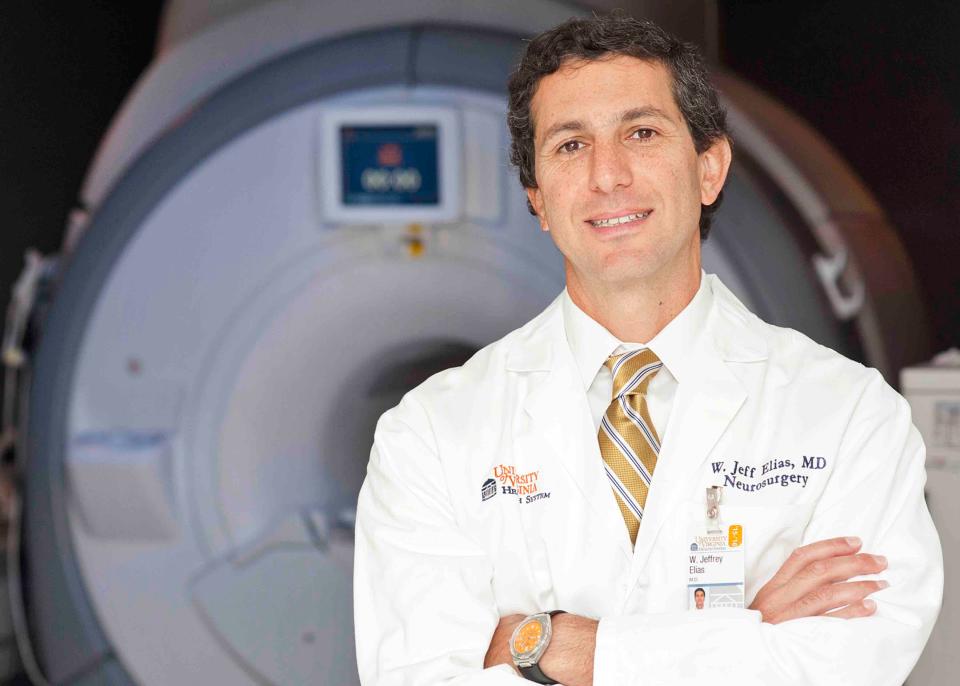Focused ultrasound trial finds promise for Parkinson’s patients: UVA research
CHARLOTTESVILLE — Sixty-nine patients with Parkinson's disease received focused-ultrasound treatment in a randomized trial. Almost 70% responded favorably to the treatment.
Thirty-nine of the participants who received the procedure continued to see significant benefits three months later, and 30 of those assessed at the one-year mark continued to see benefits.
The international trial tested a high-tech, scalpel-free approach to treating movement problems caused by Parkinson’s disease. University of Virginia Medical Center published these findings in the New England Journal of Medicine, according to a press release.

UVA neurosurgeon Dr. Jeff Elias and collaborators examined the benefits and risks of using focused ultrasound to target an area deep within the brain called the globus pallidus. The researchers wanted to see if the focused sound waves could improve trial participants’ ability to move and reduce the unwanted shaking and rigidity associated with Parkinson’s.
The procedure, researchers concluded, could be particularly useful for patients who are ineligible or unwilling to receive deep brain stimulation, a surgery that implants electrodes deep in the brain to accomplish the same symptom-management goals, the release said.
The focused-ultrasound trial results were shared with the Food and Drug Administration prior to publication and were an important consideration in the agency’s decision to expand approval of the technology for the treatment of Parkinson’s disease.
“This study is promising for patients with Parkinson’s disease and other neurological conditions. Ultrasound was precisely focused deep inside the brain to alter one of the abnormal circuits of Parkinson’s disease,” Elias said. “But it is important to understand that the treatment improved the neurological symptoms of PD and did not alter its course. Ultimately, we hope to someday cure PD.”
Focused ultrasound
The focused ultrasound procedure focuses sound waves inside the brain to disrupt faulty brain circuits, like how a magnifying glass can focus light. Unlike deep brain stimulation, the minimally invasive procedure does not require incisions or opening the skull. The procedure is guided by magnetic resonance imaging (MRI), so doctors can pinpoint the exact right spot in the brain before making any permanent changes.
Participants in the randomized Parkinson’s trial were assigned to receive either the focused-ultrasound treatment or a harmless pretend — or “sham” — procedure. In total, 69 received the actual treatment and 25 received the sham procedure. In the control group, significant improvements were seen only in patients on medication, the release said.
Side effects reported by treatment recipients included trouble speaking, difficulty walking and loss of taste. The loss of taste and difficulty walking were mild and resolved on their own, the release said. One participant continued to experience slurred speech a year after the procedure, researchers reported.
Elias’ research into the use of focused ultrasound for Parkinson’s is the latest in his more than decade-long effort to tap the vast potential of the technology. His prior work prompted the FDA to approve focused ultrasound for the treatment of essential tremor, a common movement disorder, in 2018. That approval represented a turning point for the technology and helped spur additional research at UVA and elsewhere, the release said.
UVA’s work with focused ultrasound was recently highlighted around the world by CNN’s Sanjay Gupta in a story that showcased a procedure conducted by Elias and his team.
More: Two area contractors charged, one jailed amid allegations of construction fraud
More: Pipestem State Park is an adventurer’s paradise
This article originally appeared on Staunton News Leader: Focused ultrasound trial finds promise for Parkinson’s patients

